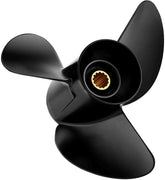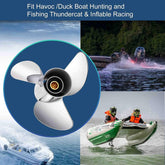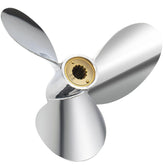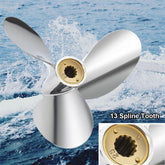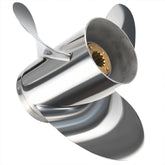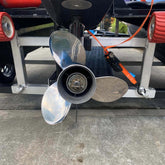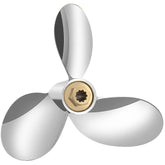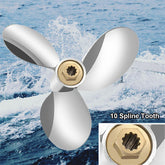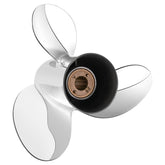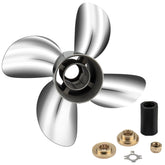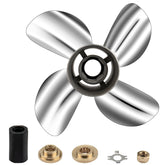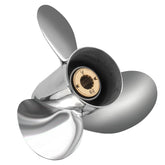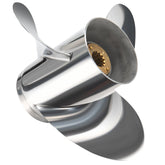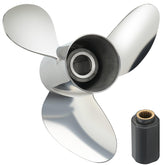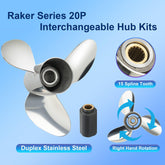How to Choose the Right Yamaha Outboard Propeller: The Ultimate 2025 Guide
Choosing the right propeller has a direct impact on how your boat performs on the water. From acceleration and cruising speed to fuel efficiency and engine health, the propeller plays a key role in overall performance. For Yamaha outboard engine users, factors like material, diameter, pitch, and blade design can vary significantly depending on your specific boat and how you use it—whether it’s fishing, water sports, or leisure cruising. In this article, we’ll walk through how to select the most suitable Yamaha outboard propeller based on engine specs and real-world use. We’ll also cover tips on how to maintain and replace your propeller to keep your setup running smoothly.
Why Your Propeller Is the Most Important Upgrade
Your propeller is the only engine component actually pushing your boat through the water. A well‑matched propeller will:
-
Deliver instant throttle response and rapid planing
-
Keep your Yamaha running in its optimal RPM band to avoid lugging or over‑revving
-
Improve fuel economy by up to 10–15% when the load is right
-
Reduce vibration and noise for a more comfortable ride
-
Extend lower‑unit life by avoiding cavitation or ventilation
In contrast, the wrong propeller can leave you embarrassed at the start line, burning extra fuel, and potentially shortening engine life. Whether you own a 9.9 HP tiller‑handle boat or a 250 HP offshore rig, investing in the right propeller is one of the smartest upgrades you can make.
Aluminum Propeller VS Stainless Propeller

-
Aluminum Props – Affordable Everyday Workhorses
-
Cost and Availability: These are roughly one‑third the price of stainless models. We stock over 120 sizes on our site, so you’ll almost always find a match for your Yamaha 2.5–300 HP engine.
-
Impact Resistance: Soft alloy blades will bend on a rock strike rather than damage your gearbox. Minor bends can be hammered back at home.
-
Performance: Expect moderate top speeds and solid acceleration. Perfect for weekend fishing boats, small pontoons, and budget‑minded anglers.
-
Why Shoppers Love Them: Keep a spare in your trunk for under $200; ideal backup for unexpected prop damage.
-
-
Stainless Steel Props – When Performance Matters
-
Blade Design: Thin, high‑strength steel blades slice water cleanly, delivering up to 3–5 MPH more top speed compared to equivalent aluminum props on the same Yamaha outboard motor.
-
Durability: Stiffer blades resist warping and handle hard impacts far better—ideal for tournament bass boats, performance runabouts, and anyone chasing max speed.
-
Cost vs. Value: While stainless costs more upfront (often $350–$400 retail), many customers recoup the fuel savings and performance gains within a season. Plus, dents are repairable by prop shops.
-
VIFProp Advantage: Our proprietary stainless alloy offers superior corrosion resistance for saltwater boaters, backed by a two‑year warranty.
-
3‑Blade vs. 4‑Blade: Which One Fits Your Fun?

-
Three‑Blade Props
-
Top Speed Focus: With less blade area, you get minimal drag and maximum top‑end speed—perfect for runabouts, center consoles, and bass boats when you’re running light.
-
Light‑Load Hole‑Shot: Accelerates adequately, though not as aggressively as a 4‑blade.
-
Price Point: Generally 15–20% cheaper than a comparable 4‑blade.
-
-
Four‑Blade Props
-
Acceleration King: The extra blade boosts thrust on take‑off—your boat planes faster, especially under heavy load or towing skiers.
-
Smooth & Stable: More blade area so less vibration at cruising RPM and better handling in chop or wake.
-
Slight Speed Trade‑Off: Expect 1–3 MPH lower top speed than a 3‑blade on the same engine—worth it for many heavy‑load scenarios.
-
Choose 3‑blade if you prioritize top speed and efficiency. Opt for 4‑blade if you carry gear, tow water‑sports, or fish rough water.
Decoding Propeller Diameter & Pitch
When choosing the right propeller, two important measurements come into play: diameter and pitch. For example, a 13x19 propeller refers to a 13-inch diameter and 19-inch pitch. Here's what each of these numbers means for your boat's performance:
Diameter: How Much Water Moves Per Revolution
The diameter refers to the width of the propeller. In this case, with a 13-inch diameter, the propeller moves a significant amount of water per revolution, which provides good thrust.
Larger Diameter: A larger diameter moves more water, which is perfect for heavier boats or those requiring greater thrust, especially when towing or at low speeds.
Too Large: If the diameter is too big, it can cause too much drag on the engine, reducing RPM and negatively affecting fuel efficiency and top speed.
For a 13-inch diameter propeller, this size offers a good balance between providing sufficient thrust and avoiding excessive drag. It’s ideal for boats that need a balance of acceleration and speed at higher RPMs.
Pitch: High Gear vs. Low Gear
The pitch of a propeller is like the gear ratio in a car. It determines how far the boat moves forward with each rotation of the propeller.
Higher Pitch (19): A 19-pitch propeller acts like a higher gear, allowing the boat to cover more distance per revolution. This results in better top speed at higher RPMs. However, with a higher pitch, you might sacrifice acceleration and hole-shot, especially at lower speeds.
Lower Pitch: Lower pitch props act like lower gears—better for quick acceleration but lower top speeds.
Your Goal: Hitting Your Boat’s WOT RPM Range
When choosing the right pitch, your goal is to hit your engine’s Wide Open Throttle (WOT) RPM range. For example, a Yamaha outboard engine typically operates at 5,000–6,500 RPM at WOT.
Under-revving: If your boat’s RPMs are too low at WOT, it means you need more thrust, and you should go for a lower pitch (e.g., 17 or 18).
Over-revving: If your RPMs are too high, you're putting too much strain on the engine, so you should opt for a higher pitch (e.g., 21).
A 13x19 propeller is great for boats that need a balance of acceleration and top-end speed. If your Yamaha outboard engine hits the WOT RPM range with ease, a 19-pitch propeller might be the perfect fit.
Match Your Prop to Your Yamaha
-
Determine Engine Specs: Identify your Yamaha model (F9.9, F150, VMAX SHO, etc.), horsepower, and gearcase type (standard vs. big‑foot vs. Sea‑Pro).
-
Identify Shaft Splines: Look at your old prop or owner’s manual—common spline counts are 7, 8, 9, 10, or 15.
-
Use Our Online Prop Selector: Go to VIFProp.com, enter your engine make/model and boat length. We’ll instantly recommend 2–4 props (with prices) that nail your target RPM and performance goals.
-
Consider Your Boat: Are you hauling a family on a pontoon? Fishing a bass tournament? Each use case can shift you toward a 3‑blade or 4‑blade, aluminum or stainless.
DIY Maintenance That Pays Off
-
After Every Salt Trip: Rinse off all salt, then lightly grease your splines with marine‑grade grease.
-
Before Each Season: Remove the prop, inspect for nicks or bends, and check the rubber hub for wear. Replace the hub if it shows cracking or deformation.
-
At First Sign of Vibration: Have your prop professionally balanced. An unbalanced prop leads to excessive lower‑unit wear.
-
Carry Spare Parts: Keep an extra cotter pin pack and prop nut on board; these small parts are surprisingly easy to lose.
Swap Your Prop in 6 Easy Steps
-
Neutral & Off: Engine off, key removed, shift in neutral.
-
Cotter Pin & Wood Block: Remove old cotter pin, wedge block behind a blade.
-
Loosen Nut: Use a prop wrench to turn the nut counter‑clockwise.
-
Pull & Inspect: Slide the prop off, inspect shaft and hub.
-
Grease & Reinstall: Grease splines, slide on new prop and thrust washer.
-
Torque & Secure: Torque to Yamaha spec, install new cotter pin, double‑check spin.
Spend 10–15 minutes tops, then get back on the water.
FAQ about Outboard Propeller
Q1: “I’ve got a 200 HP Yamaha V6 on a 25 ft offshore center console—what diameter and pitch should I start with?”
On 150–300 HP Yamaha four‑strokes (15‑tooth spline), the Yamaha aluminum YANTA Series offers a 15¼″ diameter with pitches of 15″, 17″, 19″, and 21″. Most anglers on 25 ft boats begin with 15¼″×19″, which balances acceleration and top‑end speed. If you’re carrying heavy gear or encountering big seas, you can drop to 15¼″×17″ for stronger hole‑shot; if you’re light on board and chasing top speed, try 15¼″×21″, making sure your engine’s WOT RPM stays in the 5,300–6,000 RPM target band.
Q2: “Should I switch to a stainless‑steel prop on my 250 HP Yamaha?”
Once you’re above about 200 HP, stainless‑steel props—such as Yamaha’s Saltwater Series XL or XTO OS—offer real performance gains. Their thin, rigid blades hold shape under heavy load and cut through chop with less drag. For a 250 HP V‑6, a 17⅛″ diameter, 5‑blade XTO OS prop (available in pitches up to 23″) is a popular choice. Compared to an aluminum 15¼″ prop, you’ll see quicker planing and higher cruise speed, especially in rough water.
Q3: “What’s the advantage of a 4‑blade prop on a 300 HP VMAX SHO?”
On Yamaha’s 300 HP VMAX SHO four‑strokes, the V MAX SHO Series stainless prop comes in 14¼″ diameter, 4‑blade configurations with one‑inch pitch steps (up to 22″). The extra blade area prevents ventilation and gives immediate hole‑shot—even under heavy loads or when chasing big wahoos. Compared to a 3‑blade of the same pitch, the 4‑blade SHO prop offers smoother throttle response at low RPM and more predictable handling in chop.
Q4: “How much will my WOT RPM change if I adjust pitch by one inch on a 175 HP engine?”
For Yamaha 150–300 HP engines, each one‑inch pitch shift typically alters wide‑open‑throttle RPM by about 150–200 RPM. If your tachometer shows 5,100 RPM (below the recommended 5,300–6,000 RPM), dropping pitch from 19″ to 17″ should raise your WOT by roughly 300 RPM, bringing you into the proper band. Always test on plane to confirm.
Q5: “Can I mix an aluminum YANTA prop and a stainless Saltwater prop on my 225 HP outboard to compare performance?”
Yes. Yamaha’s YANTA aluminum and Saltwater stainless props share the same 15¼″ diameter for 150–300 HP engines. You can install an aluminum 15¼″×17″ prop first, record your WOT RPM and handling, then switch to a stainless 15¼″×19″ prop of the same diameter. This direct swap lets you feel the difference in top speed, cruise efficiency, and startup thrust without changing your hull setup.
Q6: “Is a 5‑blade prop worth it on big‑tube boats or charter cats?”
For large, heavy boats that carry many passengers (like 30 ft+ catamarans), Yamaha’s XTO OS 5‑blade props (17⅛″ diameter, pitches up to 23″) excel by providing maximum thrust and minimizing slip in heavy seas. The fifth blade further reduces vibration and helps maintain cruise RPM in chop. If your boat struggles to plane or feels unstable at speed, a 5‑blade is often the solution.
Q7: “What maintenance should I do differently on a big‑HP prop compared to a small one?”
High‑HP props have larger diameters and often more blades—inspect them more vigilantly:
-
Blade Edges: Even stainless can dent; watch the leading edges for bending in rough conditions.
-
Hub Inserts: On Flo‑Torq or SDS hubs, check the rubber spider for compression—high torque can slowly degrade the inserts.
-
Balance Checks: A slight imbalance on a 15¼″ or 17⅛″ prop is more noticeable; if you feel any vibration, have the prop professionally balanced immediately to prevent lower‑unit wear.
Q8: “How do I know when to switch pitch for altitude changes on my 225 HP Yamaha?”
As you climb above sea level, air density drops and your engine loses power. For every 1,000 ft of elevation gain, you may need to lower your propeller pitch by 1 inch to maintain the same WOT RPM. For example, if your boat ran well at 19″ pitch on the coast, at 5,000 ft elevation you’d drop to 15¼″×15″ or 15¼″×17″ to keep your RPM in the 5,300–6,000 RPM range. Always recalibrate your pitch when operating at significantly different altitudes.
Ready for a propeller that makes your boat feel brand new? Visit VIFProp.com now, use our free Prop Selector, and take advantage of factory‑direct pricing on the best Yamaha outboard propellers in North America. Your boat—and your weekends—will never be the same.


